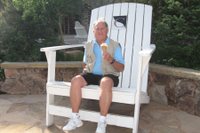We visited the other two areas of the Historic Triangle, Yorktown and Jamestown. Jamestown is the area of the first settlement in Virginia and Yorktown is the place of the last large battle between Washington and Cornwallis in the Revolutionary War.
I enjoyed the Jamestown the most of the two. It is really two areas. One is a visitor’s center and recreations of a Powhatan Village, the James Fort, and the Susan Constant and a second archeological area at the original site of the settlement. The Powhatan Indians were the natives to the area and Pocahontas was the daughter of the Chief. In the Powhatan Village in addition to the examples of homes and other things you would see in a village there were a number of people in native dress performing some of the activities you would see in a village such as basket making, scraping deer hides, and making stone tools.
The James Fort was their best guess of what the first fort was in size and contents. Recent discovers by archaeologists has required some changes but for the most part they have found the recreation to be very accurate. There you would also find a blacksmith, person demonstration the firing of a musket, and others answering questions about the other buildings in the fort all in period dress. I found it interesting that both the person firing the musket and running the blacksmith shop were both women while the original group that settled the Jamestown had no women.
The original site of the settlement is most an area set aside for archeological study. They have found the corners of the fort and many of the building in addition to many graves throughout the area.
The Yorktown area shows the area of the battle and I was not interested in visiting all of the different encampments but we did visit two houses in the area. The Thomas Nelson Jr. house is in the town of Yorktown. Nelson was a signer of the Declaration of Independence, Governor of Virginia, and commander of the Virginia Militia. He lost all his money in support of the revolution. The Moore House is located more in the area of the fighting was the site of the negotiations that lead to the British surrender on October 19, 1781.
I enjoyed the Jamestown the most of the two. It is really two areas. One is a visitor’s center and recreations of a Powhatan Village, the James Fort, and the Susan Constant and a second archeological area at the original site of the settlement. The Powhatan Indians were the natives to the area and Pocahontas was the daughter of the Chief. In the Powhatan Village in addition to the examples of homes and other things you would see in a village there were a number of people in native dress performing some of the activities you would see in a village such as basket making, scraping deer hides, and making stone tools.
The James Fort was their best guess of what the first fort was in size and contents. Recent discovers by archaeologists has required some changes but for the most part they have found the recreation to be very accurate. There you would also find a blacksmith, person demonstration the firing of a musket, and others answering questions about the other buildings in the fort all in period dress. I found it interesting that both the person firing the musket and running the blacksmith shop were both women while the original group that settled the Jamestown had no women.
The original site of the settlement is most an area set aside for archeological study. They have found the corners of the fort and many of the building in addition to many graves throughout the area.
The Yorktown area shows the area of the battle and I was not interested in visiting all of the different encampments but we did visit two houses in the area. The Thomas Nelson Jr. house is in the town of Yorktown. Nelson was a signer of the Declaration of Independence, Governor of Virginia, and commander of the Virginia Militia. He lost all his money in support of the revolution. The Moore House is located more in the area of the fighting was the site of the negotiations that lead to the British surrender on October 19, 1781.
